Critically Assessing Disability Discrimination: The Equality Act 2010
VerifiedAdded on 2023/06/14
|9
|2814
|272
Essay
AI Summary
This essay provides a critical assessment of disability discrimination within the framework of the Equality Act 2010, examining whether the Act and supporting case law achieve a balance between the rights of employers and disabled employees in the workplace. It discusses key provisions of the Act, including the prohibition of discrimination based on disability, the duty to make reasonable adjustments, and restrictions on pre-employment health inquiries. The essay also analyzes different forms of discrimination, such as direct, indirect, associative, and perceptive discrimination, referencing relevant case law like Lewisham LBC v Malcolm and Coleman v Attridge Law. Furthermore, it addresses the issue of mental illness in the workplace, highlighting the legal risks for employers and the importance of creating a supportive environment for disabled employees. The essay concludes by emphasizing the need for employers and employees to refer to the Equality Act 2010 to defend their rights and prevent unfair discrimination.
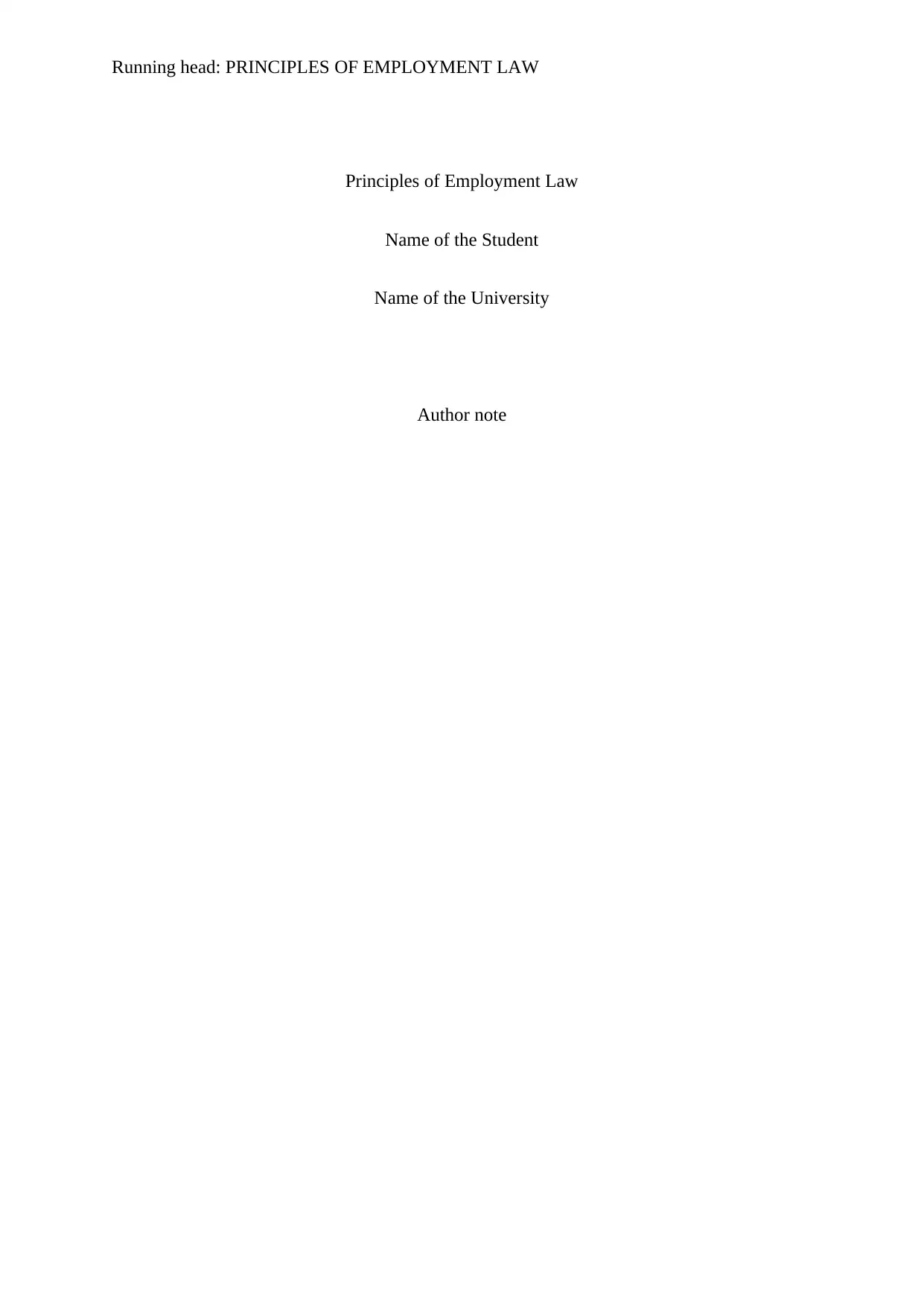
Running head: PRINCIPLES OF EMPLOYMENT LAW
Principles of Employment Law
Name of the Student
Name of the University
Author note
Principles of Employment Law
Name of the Student
Name of the University
Author note
Paraphrase This Document
Need a fresh take? Get an instant paraphrase of this document with our AI Paraphraser
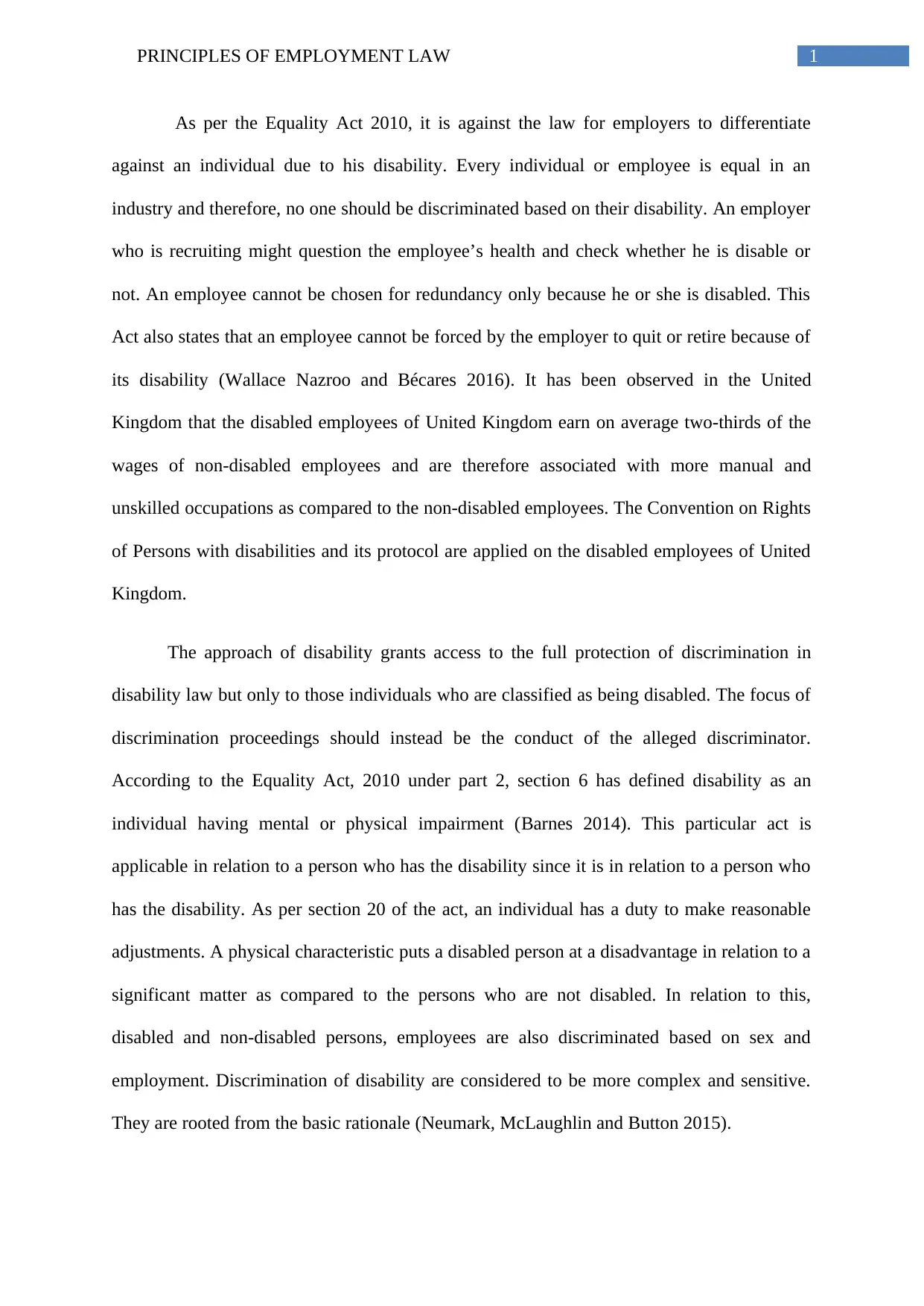
1PRINCIPLES OF EMPLOYMENT LAW
As per the Equality Act 2010, it is against the law for employers to differentiate
against an individual due to his disability. Every individual or employee is equal in an
industry and therefore, no one should be discriminated based on their disability. An employer
who is recruiting might question the employee’s health and check whether he is disable or
not. An employee cannot be chosen for redundancy only because he or she is disabled. This
Act also states that an employee cannot be forced by the employer to quit or retire because of
its disability (Wallace Nazroo and Bécares 2016). It has been observed in the United
Kingdom that the disabled employees of United Kingdom earn on average two-thirds of the
wages of non-disabled employees and are therefore associated with more manual and
unskilled occupations as compared to the non-disabled employees. The Convention on Rights
of Persons with disabilities and its protocol are applied on the disabled employees of United
Kingdom.
The approach of disability grants access to the full protection of discrimination in
disability law but only to those individuals who are classified as being disabled. The focus of
discrimination proceedings should instead be the conduct of the alleged discriminator.
According to the Equality Act, 2010 under part 2, section 6 has defined disability as an
individual having mental or physical impairment (Barnes 2014). This particular act is
applicable in relation to a person who has the disability since it is in relation to a person who
has the disability. As per section 20 of the act, an individual has a duty to make reasonable
adjustments. A physical characteristic puts a disabled person at a disadvantage in relation to a
significant matter as compared to the persons who are not disabled. In relation to this,
disabled and non-disabled persons, employees are also discriminated based on sex and
employment. Discrimination of disability are considered to be more complex and sensitive.
They are rooted from the basic rationale (Neumark, McLaughlin and Button 2015).
As per the Equality Act 2010, it is against the law for employers to differentiate
against an individual due to his disability. Every individual or employee is equal in an
industry and therefore, no one should be discriminated based on their disability. An employer
who is recruiting might question the employee’s health and check whether he is disable or
not. An employee cannot be chosen for redundancy only because he or she is disabled. This
Act also states that an employee cannot be forced by the employer to quit or retire because of
its disability (Wallace Nazroo and Bécares 2016). It has been observed in the United
Kingdom that the disabled employees of United Kingdom earn on average two-thirds of the
wages of non-disabled employees and are therefore associated with more manual and
unskilled occupations as compared to the non-disabled employees. The Convention on Rights
of Persons with disabilities and its protocol are applied on the disabled employees of United
Kingdom.
The approach of disability grants access to the full protection of discrimination in
disability law but only to those individuals who are classified as being disabled. The focus of
discrimination proceedings should instead be the conduct of the alleged discriminator.
According to the Equality Act, 2010 under part 2, section 6 has defined disability as an
individual having mental or physical impairment (Barnes 2014). This particular act is
applicable in relation to a person who has the disability since it is in relation to a person who
has the disability. As per section 20 of the act, an individual has a duty to make reasonable
adjustments. A physical characteristic puts a disabled person at a disadvantage in relation to a
significant matter as compared to the persons who are not disabled. In relation to this,
disabled and non-disabled persons, employees are also discriminated based on sex and
employment. Discrimination of disability are considered to be more complex and sensitive.
They are rooted from the basic rationale (Neumark, McLaughlin and Button 2015).
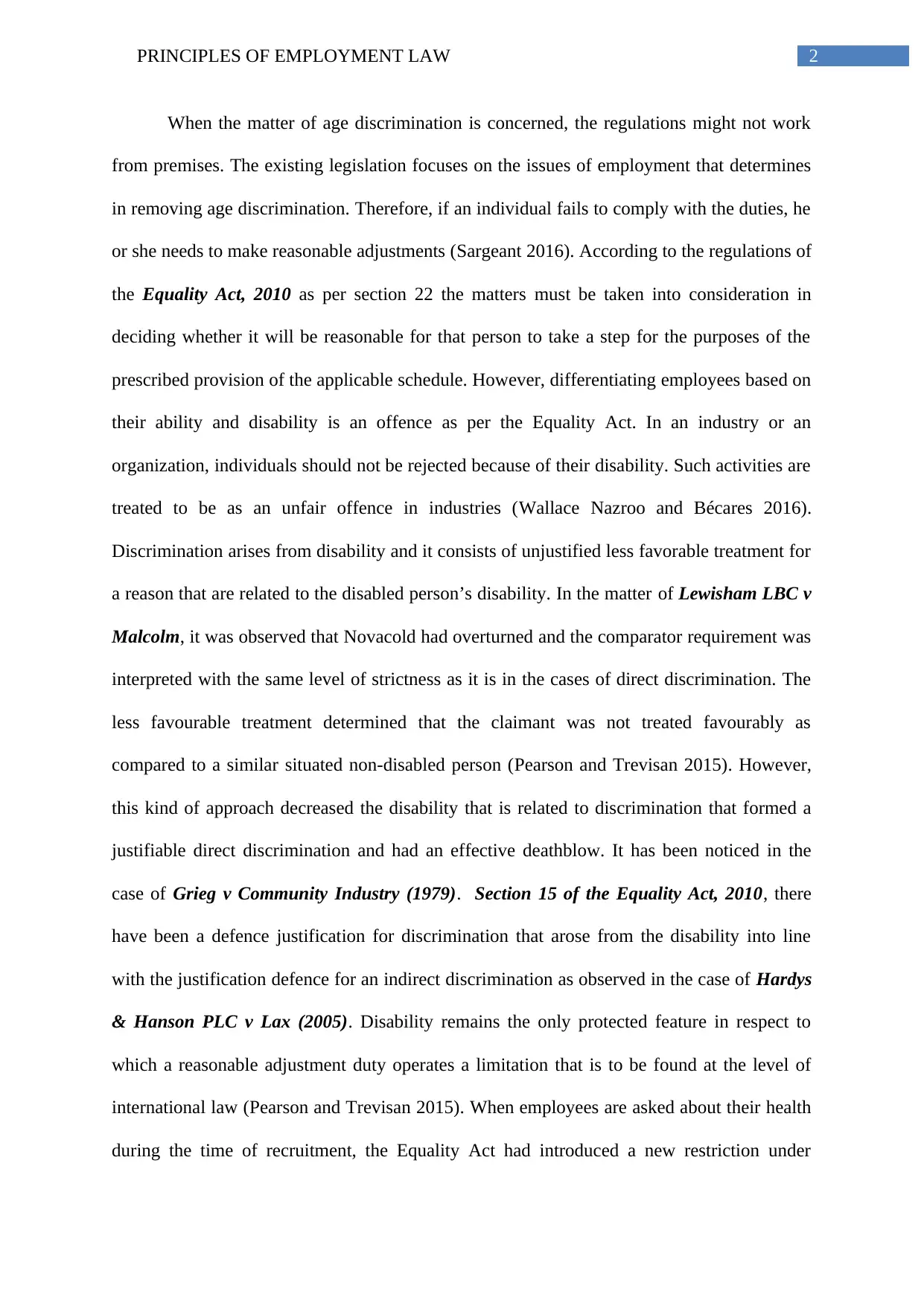
2PRINCIPLES OF EMPLOYMENT LAW
When the matter of age discrimination is concerned, the regulations might not work
from premises. The existing legislation focuses on the issues of employment that determines
in removing age discrimination. Therefore, if an individual fails to comply with the duties, he
or she needs to make reasonable adjustments (Sargeant 2016). According to the regulations of
the Equality Act, 2010 as per section 22 the matters must be taken into consideration in
deciding whether it will be reasonable for that person to take a step for the purposes of the
prescribed provision of the applicable schedule. However, differentiating employees based on
their ability and disability is an offence as per the Equality Act. In an industry or an
organization, individuals should not be rejected because of their disability. Such activities are
treated to be as an unfair offence in industries (Wallace Nazroo and Bécares 2016).
Discrimination arises from disability and it consists of unjustified less favorable treatment for
a reason that are related to the disabled person’s disability. In the matter of Lewisham LBC v
Malcolm, it was observed that Novacold had overturned and the comparator requirement was
interpreted with the same level of strictness as it is in the cases of direct discrimination. The
less favourable treatment determined that the claimant was not treated favourably as
compared to a similar situated non-disabled person (Pearson and Trevisan 2015). However,
this kind of approach decreased the disability that is related to discrimination that formed a
justifiable direct discrimination and had an effective deathblow. It has been noticed in the
case of Grieg v Community Industry (1979). Section 15 of the Equality Act, 2010, there
have been a defence justification for discrimination that arose from the disability into line
with the justification defence for an indirect discrimination as observed in the case of Hardys
& Hanson PLC v Lax (2005). Disability remains the only protected feature in respect to
which a reasonable adjustment duty operates a limitation that is to be found at the level of
international law (Pearson and Trevisan 2015). When employees are asked about their health
during the time of recruitment, the Equality Act had introduced a new restriction under
When the matter of age discrimination is concerned, the regulations might not work
from premises. The existing legislation focuses on the issues of employment that determines
in removing age discrimination. Therefore, if an individual fails to comply with the duties, he
or she needs to make reasonable adjustments (Sargeant 2016). According to the regulations of
the Equality Act, 2010 as per section 22 the matters must be taken into consideration in
deciding whether it will be reasonable for that person to take a step for the purposes of the
prescribed provision of the applicable schedule. However, differentiating employees based on
their ability and disability is an offence as per the Equality Act. In an industry or an
organization, individuals should not be rejected because of their disability. Such activities are
treated to be as an unfair offence in industries (Wallace Nazroo and Bécares 2016).
Discrimination arises from disability and it consists of unjustified less favorable treatment for
a reason that are related to the disabled person’s disability. In the matter of Lewisham LBC v
Malcolm, it was observed that Novacold had overturned and the comparator requirement was
interpreted with the same level of strictness as it is in the cases of direct discrimination. The
less favourable treatment determined that the claimant was not treated favourably as
compared to a similar situated non-disabled person (Pearson and Trevisan 2015). However,
this kind of approach decreased the disability that is related to discrimination that formed a
justifiable direct discrimination and had an effective deathblow. It has been noticed in the
case of Grieg v Community Industry (1979). Section 15 of the Equality Act, 2010, there
have been a defence justification for discrimination that arose from the disability into line
with the justification defence for an indirect discrimination as observed in the case of Hardys
& Hanson PLC v Lax (2005). Disability remains the only protected feature in respect to
which a reasonable adjustment duty operates a limitation that is to be found at the level of
international law (Pearson and Trevisan 2015). When employees are asked about their health
during the time of recruitment, the Equality Act had introduced a new restriction under
⊘ This is a preview!⊘
Do you want full access?
Subscribe today to unlock all pages.

Trusted by 1+ million students worldwide
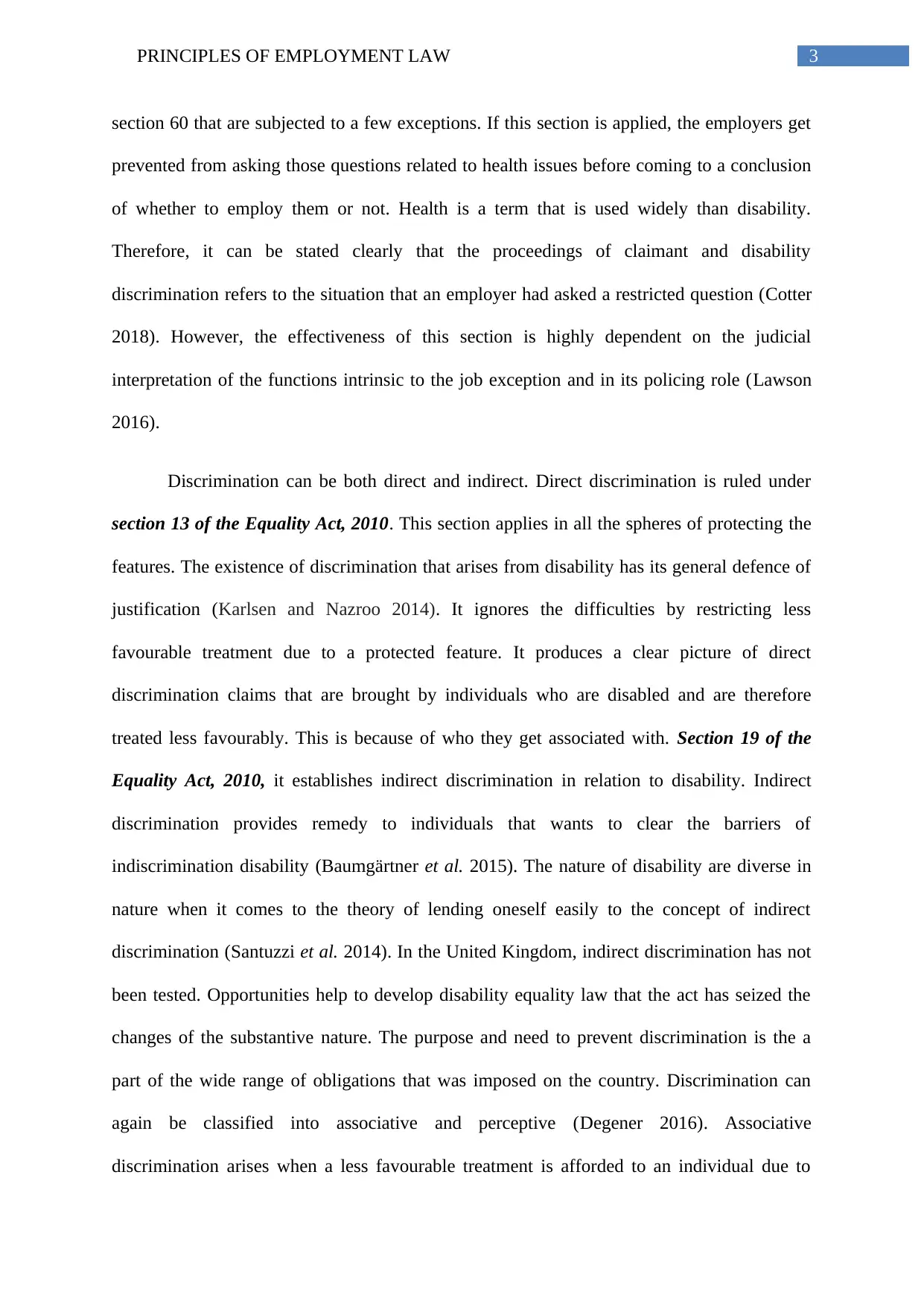
3PRINCIPLES OF EMPLOYMENT LAW
section 60 that are subjected to a few exceptions. If this section is applied, the employers get
prevented from asking those questions related to health issues before coming to a conclusion
of whether to employ them or not. Health is a term that is used widely than disability.
Therefore, it can be stated clearly that the proceedings of claimant and disability
discrimination refers to the situation that an employer had asked a restricted question (Cotter
2018). However, the effectiveness of this section is highly dependent on the judicial
interpretation of the functions intrinsic to the job exception and in its policing role (Lawson
2016).
Discrimination can be both direct and indirect. Direct discrimination is ruled under
section 13 of the Equality Act, 2010. This section applies in all the spheres of protecting the
features. The existence of discrimination that arises from disability has its general defence of
justification (Karlsen and Nazroo 2014). It ignores the difficulties by restricting less
favourable treatment due to a protected feature. It produces a clear picture of direct
discrimination claims that are brought by individuals who are disabled and are therefore
treated less favourably. This is because of who they get associated with. Section 19 of the
Equality Act, 2010, it establishes indirect discrimination in relation to disability. Indirect
discrimination provides remedy to individuals that wants to clear the barriers of
indiscrimination disability (Baumgärtner et al. 2015). The nature of disability are diverse in
nature when it comes to the theory of lending oneself easily to the concept of indirect
discrimination (Santuzzi et al. 2014). In the United Kingdom, indirect discrimination has not
been tested. Opportunities help to develop disability equality law that the act has seized the
changes of the substantive nature. The purpose and need to prevent discrimination is the a
part of the wide range of obligations that was imposed on the country. Discrimination can
again be classified into associative and perceptive (Degener 2016). Associative
discrimination arises when a less favourable treatment is afforded to an individual due to
section 60 that are subjected to a few exceptions. If this section is applied, the employers get
prevented from asking those questions related to health issues before coming to a conclusion
of whether to employ them or not. Health is a term that is used widely than disability.
Therefore, it can be stated clearly that the proceedings of claimant and disability
discrimination refers to the situation that an employer had asked a restricted question (Cotter
2018). However, the effectiveness of this section is highly dependent on the judicial
interpretation of the functions intrinsic to the job exception and in its policing role (Lawson
2016).
Discrimination can be both direct and indirect. Direct discrimination is ruled under
section 13 of the Equality Act, 2010. This section applies in all the spheres of protecting the
features. The existence of discrimination that arises from disability has its general defence of
justification (Karlsen and Nazroo 2014). It ignores the difficulties by restricting less
favourable treatment due to a protected feature. It produces a clear picture of direct
discrimination claims that are brought by individuals who are disabled and are therefore
treated less favourably. This is because of who they get associated with. Section 19 of the
Equality Act, 2010, it establishes indirect discrimination in relation to disability. Indirect
discrimination provides remedy to individuals that wants to clear the barriers of
indiscrimination disability (Baumgärtner et al. 2015). The nature of disability are diverse in
nature when it comes to the theory of lending oneself easily to the concept of indirect
discrimination (Santuzzi et al. 2014). In the United Kingdom, indirect discrimination has not
been tested. Opportunities help to develop disability equality law that the act has seized the
changes of the substantive nature. The purpose and need to prevent discrimination is the a
part of the wide range of obligations that was imposed on the country. Discrimination can
again be classified into associative and perceptive (Degener 2016). Associative
discrimination arises when a less favourable treatment is afforded to an individual due to
Paraphrase This Document
Need a fresh take? Get an instant paraphrase of this document with our AI Paraphraser
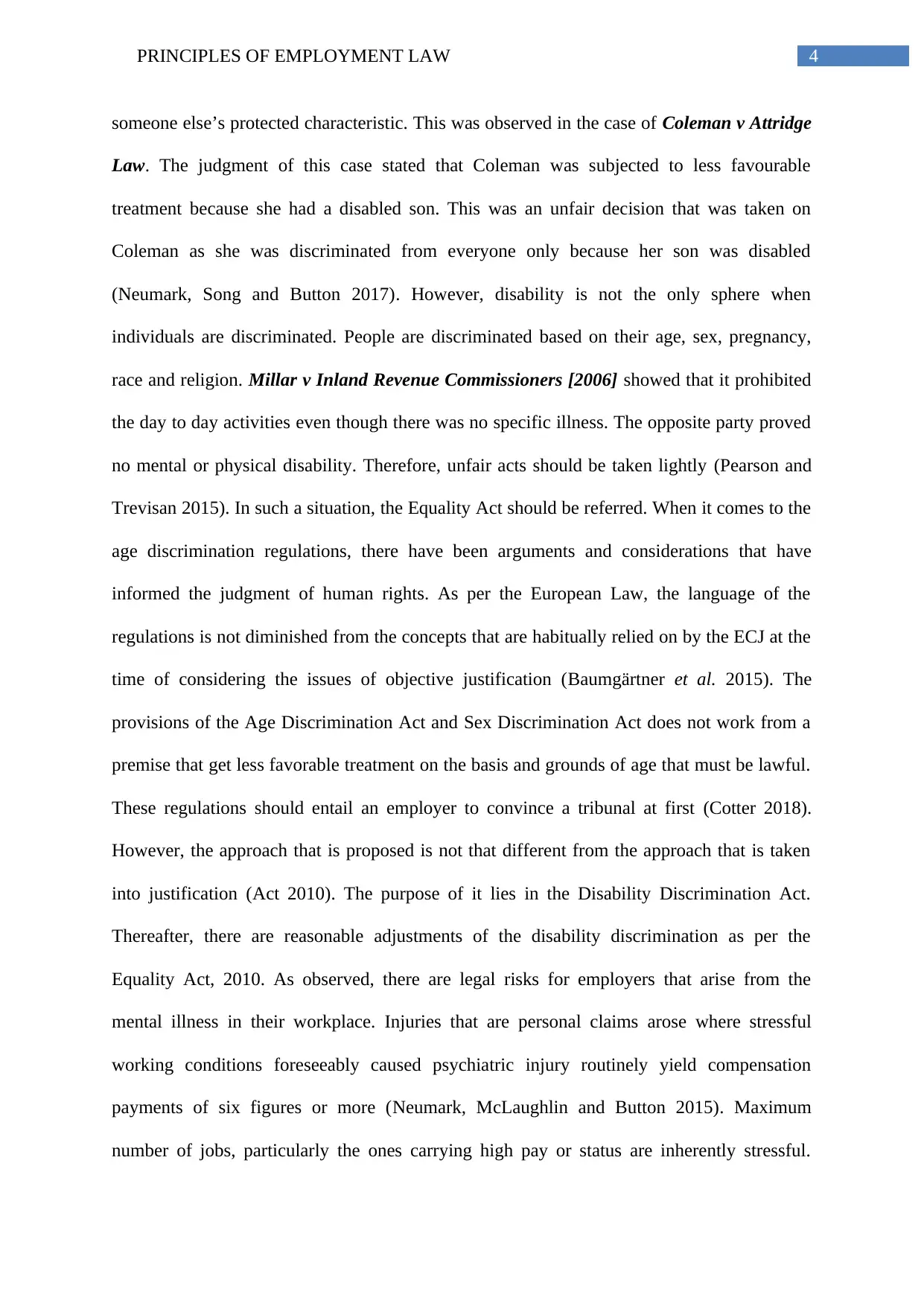
4PRINCIPLES OF EMPLOYMENT LAW
someone else’s protected characteristic. This was observed in the case of Coleman v Attridge
Law. The judgment of this case stated that Coleman was subjected to less favourable
treatment because she had a disabled son. This was an unfair decision that was taken on
Coleman as she was discriminated from everyone only because her son was disabled
(Neumark, Song and Button 2017). However, disability is not the only sphere when
individuals are discriminated. People are discriminated based on their age, sex, pregnancy,
race and religion. Millar v Inland Revenue Commissioners [2006] showed that it prohibited
the day to day activities even though there was no specific illness. The opposite party proved
no mental or physical disability. Therefore, unfair acts should be taken lightly (Pearson and
Trevisan 2015). In such a situation, the Equality Act should be referred. When it comes to the
age discrimination regulations, there have been arguments and considerations that have
informed the judgment of human rights. As per the European Law, the language of the
regulations is not diminished from the concepts that are habitually relied on by the ECJ at the
time of considering the issues of objective justification (Baumgärtner et al. 2015). The
provisions of the Age Discrimination Act and Sex Discrimination Act does not work from a
premise that get less favorable treatment on the basis and grounds of age that must be lawful.
These regulations should entail an employer to convince a tribunal at first (Cotter 2018).
However, the approach that is proposed is not that different from the approach that is taken
into justification (Act 2010). The purpose of it lies in the Disability Discrimination Act.
Thereafter, there are reasonable adjustments of the disability discrimination as per the
Equality Act, 2010. As observed, there are legal risks for employers that arise from the
mental illness in their workplace. Injuries that are personal claims arose where stressful
working conditions foreseeably caused psychiatric injury routinely yield compensation
payments of six figures or more (Neumark, McLaughlin and Button 2015). Maximum
number of jobs, particularly the ones carrying high pay or status are inherently stressful.
someone else’s protected characteristic. This was observed in the case of Coleman v Attridge
Law. The judgment of this case stated that Coleman was subjected to less favourable
treatment because she had a disabled son. This was an unfair decision that was taken on
Coleman as she was discriminated from everyone only because her son was disabled
(Neumark, Song and Button 2017). However, disability is not the only sphere when
individuals are discriminated. People are discriminated based on their age, sex, pregnancy,
race and religion. Millar v Inland Revenue Commissioners [2006] showed that it prohibited
the day to day activities even though there was no specific illness. The opposite party proved
no mental or physical disability. Therefore, unfair acts should be taken lightly (Pearson and
Trevisan 2015). In such a situation, the Equality Act should be referred. When it comes to the
age discrimination regulations, there have been arguments and considerations that have
informed the judgment of human rights. As per the European Law, the language of the
regulations is not diminished from the concepts that are habitually relied on by the ECJ at the
time of considering the issues of objective justification (Baumgärtner et al. 2015). The
provisions of the Age Discrimination Act and Sex Discrimination Act does not work from a
premise that get less favorable treatment on the basis and grounds of age that must be lawful.
These regulations should entail an employer to convince a tribunal at first (Cotter 2018).
However, the approach that is proposed is not that different from the approach that is taken
into justification (Act 2010). The purpose of it lies in the Disability Discrimination Act.
Thereafter, there are reasonable adjustments of the disability discrimination as per the
Equality Act, 2010. As observed, there are legal risks for employers that arise from the
mental illness in their workplace. Injuries that are personal claims arose where stressful
working conditions foreseeably caused psychiatric injury routinely yield compensation
payments of six figures or more (Neumark, McLaughlin and Button 2015). Maximum
number of jobs, particularly the ones carrying high pay or status are inherently stressful.
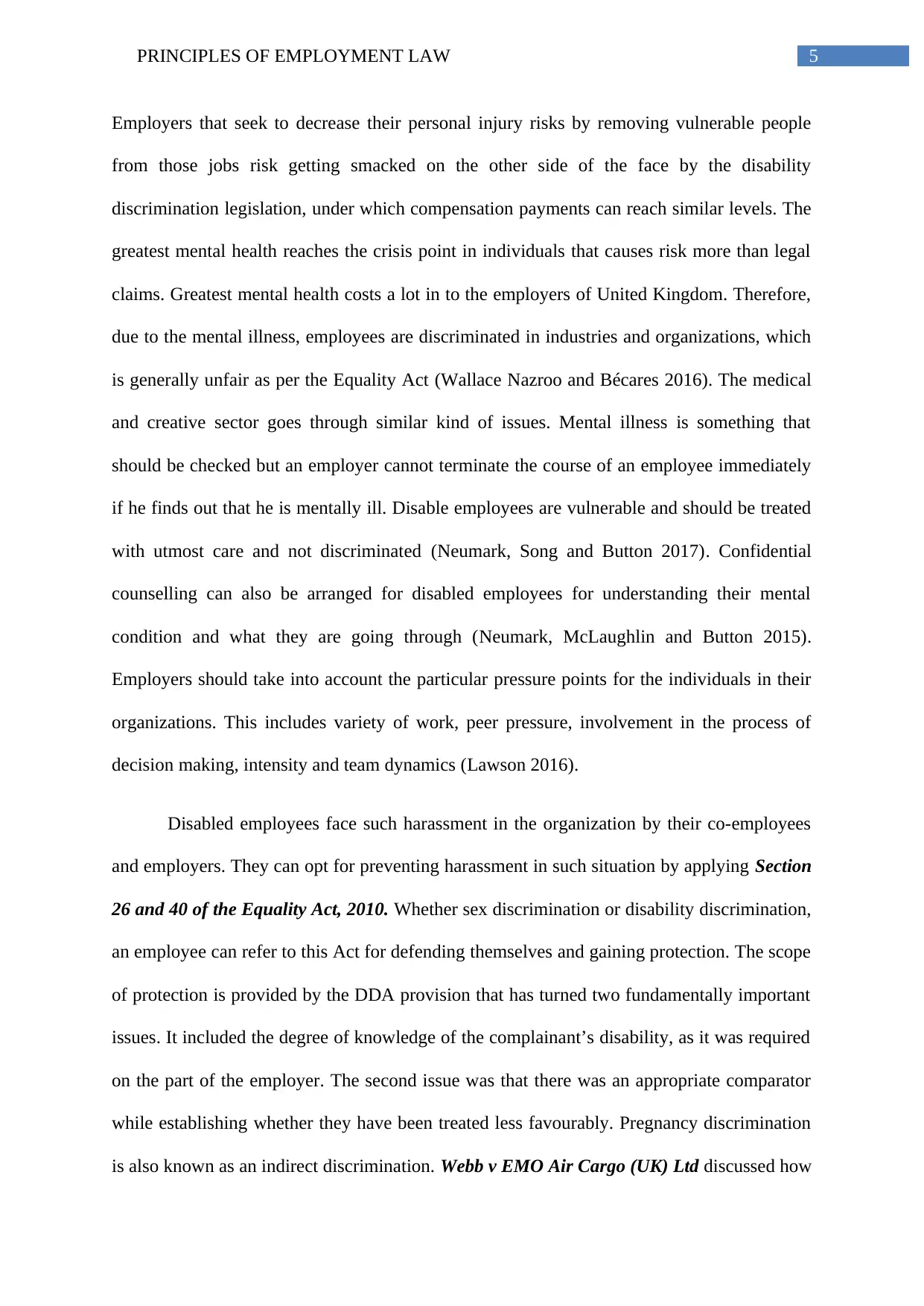
5PRINCIPLES OF EMPLOYMENT LAW
Employers that seek to decrease their personal injury risks by removing vulnerable people
from those jobs risk getting smacked on the other side of the face by the disability
discrimination legislation, under which compensation payments can reach similar levels. The
greatest mental health reaches the crisis point in individuals that causes risk more than legal
claims. Greatest mental health costs a lot in to the employers of United Kingdom. Therefore,
due to the mental illness, employees are discriminated in industries and organizations, which
is generally unfair as per the Equality Act (Wallace Nazroo and Bécares 2016). The medical
and creative sector goes through similar kind of issues. Mental illness is something that
should be checked but an employer cannot terminate the course of an employee immediately
if he finds out that he is mentally ill. Disable employees are vulnerable and should be treated
with utmost care and not discriminated (Neumark, Song and Button 2017). Confidential
counselling can also be arranged for disabled employees for understanding their mental
condition and what they are going through (Neumark, McLaughlin and Button 2015).
Employers should take into account the particular pressure points for the individuals in their
organizations. This includes variety of work, peer pressure, involvement in the process of
decision making, intensity and team dynamics (Lawson 2016).
Disabled employees face such harassment in the organization by their co-employees
and employers. They can opt for preventing harassment in such situation by applying Section
26 and 40 of the Equality Act, 2010. Whether sex discrimination or disability discrimination,
an employee can refer to this Act for defending themselves and gaining protection. The scope
of protection is provided by the DDA provision that has turned two fundamentally important
issues. It included the degree of knowledge of the complainant’s disability, as it was required
on the part of the employer. The second issue was that there was an appropriate comparator
while establishing whether they have been treated less favourably. Pregnancy discrimination
is also known as an indirect discrimination. Webb v EMO Air Cargo (UK) Ltd discussed how
Employers that seek to decrease their personal injury risks by removing vulnerable people
from those jobs risk getting smacked on the other side of the face by the disability
discrimination legislation, under which compensation payments can reach similar levels. The
greatest mental health reaches the crisis point in individuals that causes risk more than legal
claims. Greatest mental health costs a lot in to the employers of United Kingdom. Therefore,
due to the mental illness, employees are discriminated in industries and organizations, which
is generally unfair as per the Equality Act (Wallace Nazroo and Bécares 2016). The medical
and creative sector goes through similar kind of issues. Mental illness is something that
should be checked but an employer cannot terminate the course of an employee immediately
if he finds out that he is mentally ill. Disable employees are vulnerable and should be treated
with utmost care and not discriminated (Neumark, Song and Button 2017). Confidential
counselling can also be arranged for disabled employees for understanding their mental
condition and what they are going through (Neumark, McLaughlin and Button 2015).
Employers should take into account the particular pressure points for the individuals in their
organizations. This includes variety of work, peer pressure, involvement in the process of
decision making, intensity and team dynamics (Lawson 2016).
Disabled employees face such harassment in the organization by their co-employees
and employers. They can opt for preventing harassment in such situation by applying Section
26 and 40 of the Equality Act, 2010. Whether sex discrimination or disability discrimination,
an employee can refer to this Act for defending themselves and gaining protection. The scope
of protection is provided by the DDA provision that has turned two fundamentally important
issues. It included the degree of knowledge of the complainant’s disability, as it was required
on the part of the employer. The second issue was that there was an appropriate comparator
while establishing whether they have been treated less favourably. Pregnancy discrimination
is also known as an indirect discrimination. Webb v EMO Air Cargo (UK) Ltd discussed how
⊘ This is a preview!⊘
Do you want full access?
Subscribe today to unlock all pages.

Trusted by 1+ million students worldwide
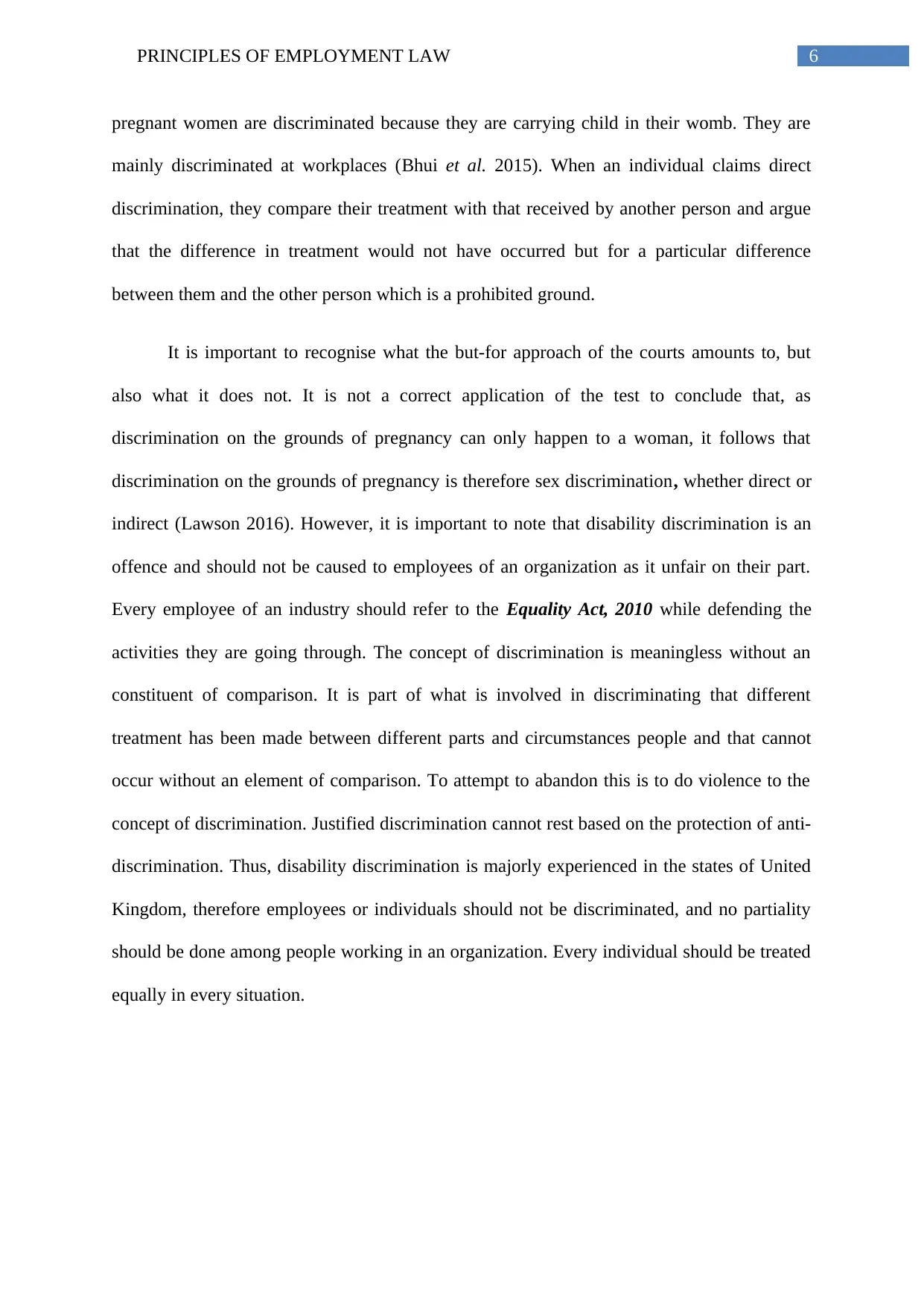
6PRINCIPLES OF EMPLOYMENT LAW
pregnant women are discriminated because they are carrying child in their womb. They are
mainly discriminated at workplaces (Bhui et al. 2015). When an individual claims direct
discrimination, they compare their treatment with that received by another person and argue
that the difference in treatment would not have occurred but for a particular difference
between them and the other person which is a prohibited ground.
It is important to recognise what the but-for approach of the courts amounts to, but
also what it does not. It is not a correct application of the test to conclude that, as
discrimination on the grounds of pregnancy can only happen to a woman, it follows that
discrimination on the grounds of pregnancy is therefore sex discrimination, whether direct or
indirect (Lawson 2016). However, it is important to note that disability discrimination is an
offence and should not be caused to employees of an organization as it unfair on their part.
Every employee of an industry should refer to the Equality Act, 2010 while defending the
activities they are going through. The concept of discrimination is meaningless without an
constituent of comparison. It is part of what is involved in discriminating that different
treatment has been made between different parts and circumstances people and that cannot
occur without an element of comparison. To attempt to abandon this is to do violence to the
concept of discrimination. Justified discrimination cannot rest based on the protection of anti-
discrimination. Thus, disability discrimination is majorly experienced in the states of United
Kingdom, therefore employees or individuals should not be discriminated, and no partiality
should be done among people working in an organization. Every individual should be treated
equally in every situation.
pregnant women are discriminated because they are carrying child in their womb. They are
mainly discriminated at workplaces (Bhui et al. 2015). When an individual claims direct
discrimination, they compare their treatment with that received by another person and argue
that the difference in treatment would not have occurred but for a particular difference
between them and the other person which is a prohibited ground.
It is important to recognise what the but-for approach of the courts amounts to, but
also what it does not. It is not a correct application of the test to conclude that, as
discrimination on the grounds of pregnancy can only happen to a woman, it follows that
discrimination on the grounds of pregnancy is therefore sex discrimination, whether direct or
indirect (Lawson 2016). However, it is important to note that disability discrimination is an
offence and should not be caused to employees of an organization as it unfair on their part.
Every employee of an industry should refer to the Equality Act, 2010 while defending the
activities they are going through. The concept of discrimination is meaningless without an
constituent of comparison. It is part of what is involved in discriminating that different
treatment has been made between different parts and circumstances people and that cannot
occur without an element of comparison. To attempt to abandon this is to do violence to the
concept of discrimination. Justified discrimination cannot rest based on the protection of anti-
discrimination. Thus, disability discrimination is majorly experienced in the states of United
Kingdom, therefore employees or individuals should not be discriminated, and no partiality
should be done among people working in an organization. Every individual should be treated
equally in every situation.
Paraphrase This Document
Need a fresh take? Get an instant paraphrase of this document with our AI Paraphraser
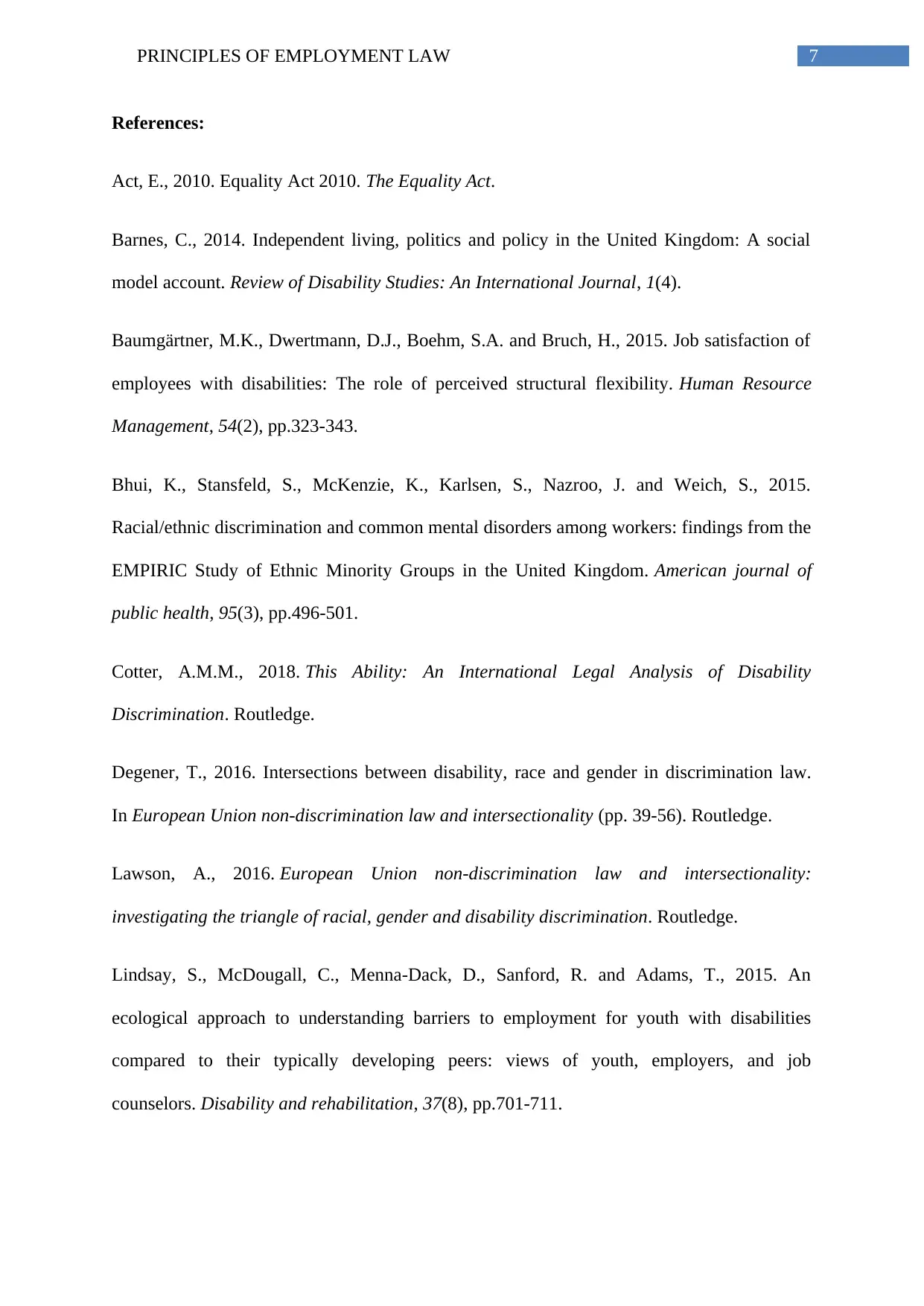
7PRINCIPLES OF EMPLOYMENT LAW
References:
Act, E., 2010. Equality Act 2010. The Equality Act.
Barnes, C., 2014. Independent living, politics and policy in the United Kingdom: A social
model account. Review of Disability Studies: An International Journal, 1(4).
Baumgärtner, M.K., Dwertmann, D.J., Boehm, S.A. and Bruch, H., 2015. Job satisfaction of
employees with disabilities: The role of perceived structural flexibility. Human Resource
Management, 54(2), pp.323-343.
Bhui, K., Stansfeld, S., McKenzie, K., Karlsen, S., Nazroo, J. and Weich, S., 2015.
Racial/ethnic discrimination and common mental disorders among workers: findings from the
EMPIRIC Study of Ethnic Minority Groups in the United Kingdom. American journal of
public health, 95(3), pp.496-501.
Cotter, A.M.M., 2018. This Ability: An International Legal Analysis of Disability
Discrimination. Routledge.
Degener, T., 2016. Intersections between disability, race and gender in discrimination law.
In European Union non-discrimination law and intersectionality (pp. 39-56). Routledge.
Lawson, A., 2016. European Union non-discrimination law and intersectionality:
investigating the triangle of racial, gender and disability discrimination. Routledge.
Lindsay, S., McDougall, C., Menna-Dack, D., Sanford, R. and Adams, T., 2015. An
ecological approach to understanding barriers to employment for youth with disabilities
compared to their typically developing peers: views of youth, employers, and job
counselors. Disability and rehabilitation, 37(8), pp.701-711.
References:
Act, E., 2010. Equality Act 2010. The Equality Act.
Barnes, C., 2014. Independent living, politics and policy in the United Kingdom: A social
model account. Review of Disability Studies: An International Journal, 1(4).
Baumgärtner, M.K., Dwertmann, D.J., Boehm, S.A. and Bruch, H., 2015. Job satisfaction of
employees with disabilities: The role of perceived structural flexibility. Human Resource
Management, 54(2), pp.323-343.
Bhui, K., Stansfeld, S., McKenzie, K., Karlsen, S., Nazroo, J. and Weich, S., 2015.
Racial/ethnic discrimination and common mental disorders among workers: findings from the
EMPIRIC Study of Ethnic Minority Groups in the United Kingdom. American journal of
public health, 95(3), pp.496-501.
Cotter, A.M.M., 2018. This Ability: An International Legal Analysis of Disability
Discrimination. Routledge.
Degener, T., 2016. Intersections between disability, race and gender in discrimination law.
In European Union non-discrimination law and intersectionality (pp. 39-56). Routledge.
Lawson, A., 2016. European Union non-discrimination law and intersectionality:
investigating the triangle of racial, gender and disability discrimination. Routledge.
Lindsay, S., McDougall, C., Menna-Dack, D., Sanford, R. and Adams, T., 2015. An
ecological approach to understanding barriers to employment for youth with disabilities
compared to their typically developing peers: views of youth, employers, and job
counselors. Disability and rehabilitation, 37(8), pp.701-711.
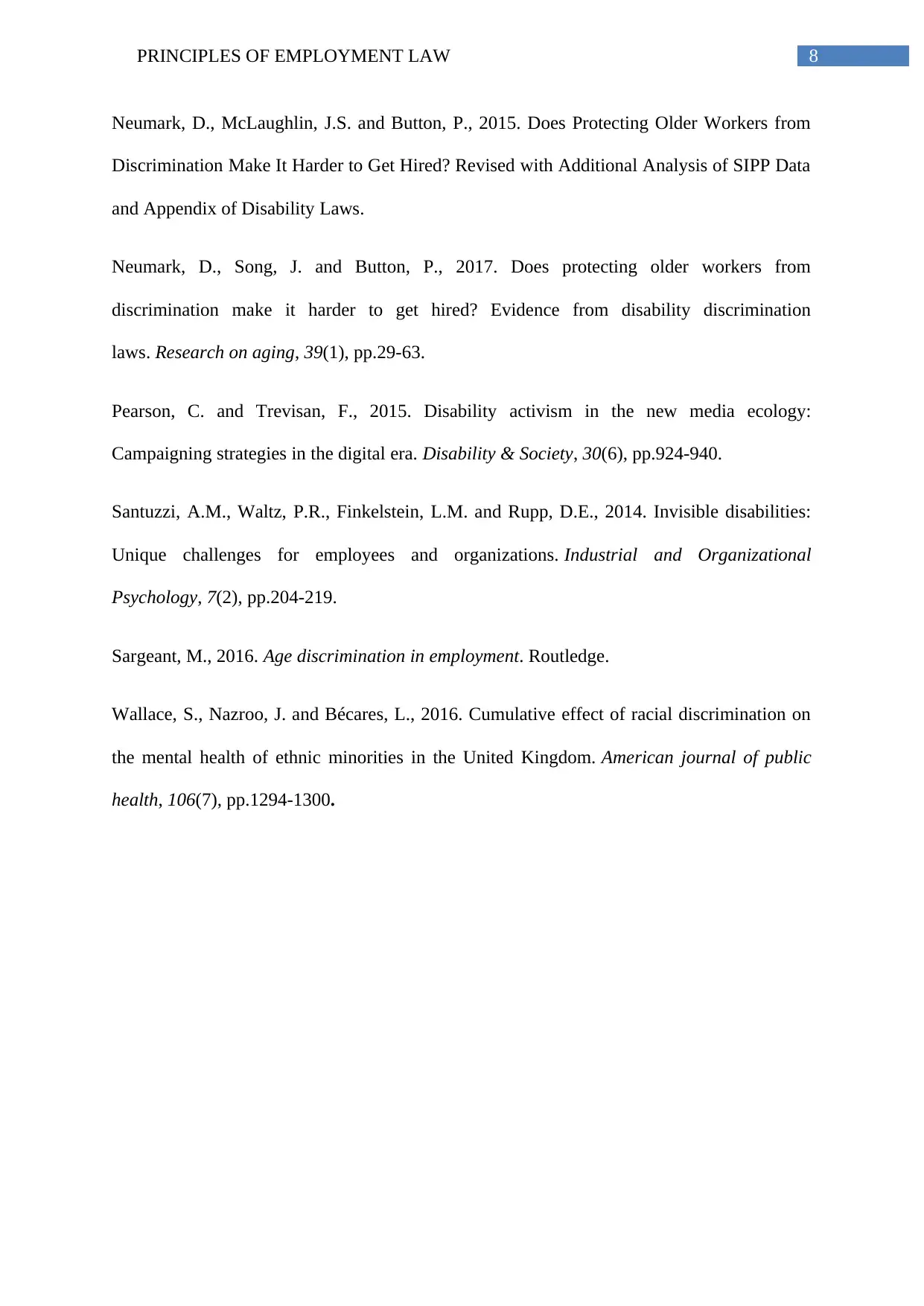
8PRINCIPLES OF EMPLOYMENT LAW
Neumark, D., McLaughlin, J.S. and Button, P., 2015. Does Protecting Older Workers from
Discrimination Make It Harder to Get Hired? Revised with Additional Analysis of SIPP Data
and Appendix of Disability Laws.
Neumark, D., Song, J. and Button, P., 2017. Does protecting older workers from
discrimination make it harder to get hired? Evidence from disability discrimination
laws. Research on aging, 39(1), pp.29-63.
Pearson, C. and Trevisan, F., 2015. Disability activism in the new media ecology:
Campaigning strategies in the digital era. Disability & Society, 30(6), pp.924-940.
Santuzzi, A.M., Waltz, P.R., Finkelstein, L.M. and Rupp, D.E., 2014. Invisible disabilities:
Unique challenges for employees and organizations. Industrial and Organizational
Psychology, 7(2), pp.204-219.
Sargeant, M., 2016. Age discrimination in employment. Routledge.
Wallace, S., Nazroo, J. and Bécares, L., 2016. Cumulative effect of racial discrimination on
the mental health of ethnic minorities in the United Kingdom. American journal of public
health, 106(7), pp.1294-1300.
Neumark, D., McLaughlin, J.S. and Button, P., 2015. Does Protecting Older Workers from
Discrimination Make It Harder to Get Hired? Revised with Additional Analysis of SIPP Data
and Appendix of Disability Laws.
Neumark, D., Song, J. and Button, P., 2017. Does protecting older workers from
discrimination make it harder to get hired? Evidence from disability discrimination
laws. Research on aging, 39(1), pp.29-63.
Pearson, C. and Trevisan, F., 2015. Disability activism in the new media ecology:
Campaigning strategies in the digital era. Disability & Society, 30(6), pp.924-940.
Santuzzi, A.M., Waltz, P.R., Finkelstein, L.M. and Rupp, D.E., 2014. Invisible disabilities:
Unique challenges for employees and organizations. Industrial and Organizational
Psychology, 7(2), pp.204-219.
Sargeant, M., 2016. Age discrimination in employment. Routledge.
Wallace, S., Nazroo, J. and Bécares, L., 2016. Cumulative effect of racial discrimination on
the mental health of ethnic minorities in the United Kingdom. American journal of public
health, 106(7), pp.1294-1300.
⊘ This is a preview!⊘
Do you want full access?
Subscribe today to unlock all pages.

Trusted by 1+ million students worldwide
1 out of 9
Related Documents
Your All-in-One AI-Powered Toolkit for Academic Success.
+13062052269
info@desklib.com
Available 24*7 on WhatsApp / Email
![[object Object]](/_next/static/media/star-bottom.7253800d.svg)
Unlock your academic potential
Copyright © 2020–2025 A2Z Services. All Rights Reserved. Developed and managed by ZUCOL.




